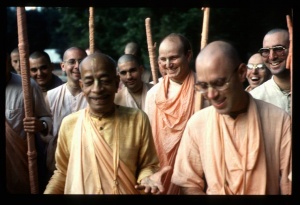CC Madhya 18.3 (1975): Difference between revisions
(Vanibot #0027: CCMirror - Mirror CC's 1996 edition to form a basis for 1975) |
(Vanibot #0020: VersionCompareLinker - added a link to the Version Compare feature) |
||
| Line 2: | Line 2: | ||
<div style="float:left">'''[[Sri Caitanya-caritamrta (1975)|Śrī Caitanya-caritāmṛta (1975)]] - [[CC Madhya (1975)|Madhya-līlā]] - [[CC Madhya 18 (1975)|Chapter 18: Lord Śrī Caitanya Mahāprabhu's Visit to Śrī Vṛndāvana]]'''</div> | <div style="float:left">'''[[Sri Caitanya-caritamrta (1975)|Śrī Caitanya-caritāmṛta (1975)]] - [[CC Madhya (1975)|Madhya-līlā]] - [[CC Madhya 18 (1975)|Chapter 18: Lord Śrī Caitanya Mahāprabhu's Visit to Śrī Vṛndāvana]]'''</div> | ||
<div style="float:right">[[File:Go-previous.png|link=CC Madhya 18.2 (1975)|Madhya-līlā 18.2]] '''[[CC Madhya 18.2 (1975)|Madhya-līlā 18.2]] - [[CC Madhya 18.4 (1975)|Madhya-līlā 18.4]]''' [[File:Go-next.png|link=CC Madhya 18.4 (1975)|Madhya-līlā 18.4]]</div> | <div style="float:right">[[File:Go-previous.png|link=CC Madhya 18.2 (1975)|Madhya-līlā 18.2]] '''[[CC Madhya 18.2 (1975)|Madhya-līlā 18.2]] - [[CC Madhya 18.4 (1975)|Madhya-līlā 18.4]]''' [[File:Go-next.png|link=CC Madhya 18.4 (1975)|Madhya-līlā 18.4]]</div> | ||
{{CompareVersions|CC|Madhya 18.3|CC 1975|CC 1996}} | |||
{{RandomImage}} | {{RandomImage}} | ||
==== TEXT 3 ==== | ==== TEXT 3 ==== | ||
| Line 11: | Line 10: | ||
<div class="verse"> | <div class="verse"> | ||
:ei-mata mahāprabhu nācite nācite | :ei-mata mahāprabhu nācite nācite | ||
: | :'āriṭ'-grāme āsi' 'bāhya' haila ācambite | ||
</div> | </div> | ||
| Line 18: | Line 17: | ||
<div class="synonyms"> | <div class="synonyms"> | ||
ei-mata—in this way; mahāprabhu—Śrī Caitanya Mahāprabhu; nācite nācite—dancing and dancing; āriṭ-grāme—in the village known as Āriṭ-grāma; | ei-mata—in this way; mahāprabhu—Śrī Caitanya Mahāprabhu; nācite nācite—dancing and dancing; āriṭ-grāme—in the village known as Āriṭ-grāma; āsi,—coming; bāhya—sense perception; haila—there was; ācambite—suddenly. | ||
</div> | </div> | ||
| Line 25: | Line 24: | ||
<div class="translation"> | <div class="translation"> | ||
Śrī Caitanya Mahāprabhu danced in ecstasy, but when He arrived at | Śrī Caitanya Mahāprabhu danced in ecstasy, but when He arrived at Āriṭgrāma, His sense perception was awakened. | ||
</div> | </div> | ||
| Line 32: | Line 31: | ||
<div class="purport"> | <div class="purport"> | ||
Āriṭ-grāma is also called Ariṣṭa-grāma. Śrī Caitanya Mahāprabhu understood that in that village Ariṣṭāsura | Āriṭ-grāma is also called Ariṣṭa-grāma. Śrī Caitanya Mahāprabhu understood that in that village, Ariṣṭāsura was killed by Śrī Kṛṣṇa. While there, He inquired about Rādhā-kuṇḍa, but no one could tell Him where it was. The brāhmaṇa accompanying Him could also not ascertain its whereabouts. Śrī Caitanya Mahāprabhu could then understand that the holy places known as Rādhā-kuṇḍa and Śyāma-kuṇḍa were at that time lost to everyone's vision. He therefore discovered Rādhā-kuṇḍa and Śyāma-kuṇḍa, which were two reservoirs of water in two paddy fields. Although there was very little water, Śrī Caitanya Mahāprabhu was omniscient and could understand that formerly these two ponds were called Śrī Rādhā-kuṇḍa and Śyāma-kuṇḍa. In this way Rādhā-kuṇḍa and Śyāma-kuṇḍa were discovered. | ||
</div> | </div> | ||
Latest revision as of 11:26, 27 January 2020

A.C. Bhaktivedanta Swami Prabhupada
TEXT 3
- ei-mata mahāprabhu nācite nācite
- 'āriṭ'-grāme āsi' 'bāhya' haila ācambite
SYNONYMS
ei-mata—in this way; mahāprabhu—Śrī Caitanya Mahāprabhu; nācite nācite—dancing and dancing; āriṭ-grāme—in the village known as Āriṭ-grāma; āsi,—coming; bāhya—sense perception; haila—there was; ācambite—suddenly.
TRANSLATION
Śrī Caitanya Mahāprabhu danced in ecstasy, but when He arrived at Āriṭgrāma, His sense perception was awakened.
PURPORT
Āriṭ-grāma is also called Ariṣṭa-grāma. Śrī Caitanya Mahāprabhu understood that in that village, Ariṣṭāsura was killed by Śrī Kṛṣṇa. While there, He inquired about Rādhā-kuṇḍa, but no one could tell Him where it was. The brāhmaṇa accompanying Him could also not ascertain its whereabouts. Śrī Caitanya Mahāprabhu could then understand that the holy places known as Rādhā-kuṇḍa and Śyāma-kuṇḍa were at that time lost to everyone's vision. He therefore discovered Rādhā-kuṇḍa and Śyāma-kuṇḍa, which were two reservoirs of water in two paddy fields. Although there was very little water, Śrī Caitanya Mahāprabhu was omniscient and could understand that formerly these two ponds were called Śrī Rādhā-kuṇḍa and Śyāma-kuṇḍa. In this way Rādhā-kuṇḍa and Śyāma-kuṇḍa were discovered.